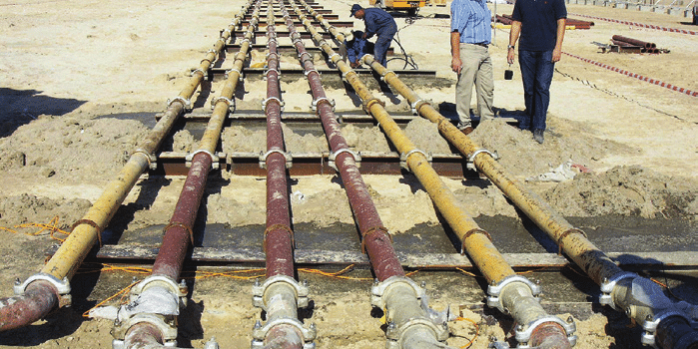1. The casing is buried
( 1) The construction site is level and the operation platform is free of debris.
(2) The surveyor completes the stakeout center center and sets the cross guard pile on site. After the casing is buried, the position shall be checked. The position deviation of the casing shall not exceed 125px and the inclination shall not exceed 1%.
(3) The thickness of the steel plate of the steel casing should meet the requirements of the actual pile diameter for the strength and rigidity of the steel casing. The thickness of the steel plate is not less than 8 mm.
(4) The casing should be larger than the pile diameter of 500px and 750px above the ground.
2. Drilling construction
( 1) Before the drilling rig is in place, the preparation work for drilling should be checked. The base of the rig and the main structure of the frame should be stable after installation, and there should be no displacement or subsidence during drilling. After the position is completed, the construction team will perform a self-check on the rig: the alignment of the drill bit, whether the machine is level, and whether the support is stable.
(2) The drilling operation should be carried out in batches, fill in the drilling construction record, and the drilling situation and the next shift should be noted when handing over the shift. The drilling mud and drilling rig should be inspected frequently (the drill bit and the drill pipe deviate from the center of the pile and the machine is not flat or inclined). If it does not meet the requirements, it should be corrected and adjusted in time. Attention should be paid to the change of the formation. The slag should be preserved at the change of the stratum. The storage should be marked with the label, the sampling stratum, the depth (elevation) and the sampling time.
(3) During the drilling process, the change of the location of the host and the support of the foot should be observed, and the settlement phenomenon should be stopped in time. If the downtime is long, the casing hook should be hung.
(4) During the drilling process, the head change is observed at all times. If there is a drop of water, the technician should immediately report to the technical person in charge, investigate the situation, and take necessary measures.
(5) At the change of the stratum, the drill slag sample should be taken at the slag outlet, washed and collected in a special bag, and the soil and elevation are marked to determine the final hole elevation.
concrete pump pipe manufacturer engineering quality assurance measures
1. The construction personnel should be familiar with the drawings and technical documents, and strictly follow the design drawings and relevant operational specifications.
2, all projects, all processes must be strictly in accordance with the norms, procedures, construction, to be meticulous, not to cut corners, not rough.
3. Each work session shall have a special person to test the construction parameters, formulate a self-inspection and self-correction system for the team, and accept random inspections by Party A and the supervisors to ensure the quality of the project and eliminate hidden dangers.
4. The cement entering the site must have the permit issued by Shenzhen City. Each batch of cement must have a manufacturer certificate, and it should be sent to the quality inspection department for testing according to the regulations.
5. Accumulate the original materials in a timely, complete, true and correct manner, and regularly submit relevant materials that meet the acceptance criteria to Party A and the supervisor.
6. Concealed works must be completed by the Party A and the supervisors before the next process can be carried out.
7. Adopt information dynamic construction method for technical management, conduct strict monitoring, and timely feedback information so as to take effective measures to solve problems in construction.
8. The inspection records should be made during the construction process, and the problems should be remedied in time until the design requirements are met.
The “concrete pump pipe” high wear-resistant concrete pump truck transports double-layer hardened tubes (straight tubes, reducers, bends, etc.) to fill the gap in the market. The double-layer hardened tube product is a second-generation high-tech product developed on the basis of high wear-resistant hardened pipe fittings. It adopts special equipment and high-frequency inner wall heat treatment technology. The hardness reaches 60-65HRC and the wear-resistant layer thickness is 2.5-3mm. It solves the drawbacks of the fracture tube of the hardened tube in the case of thickening of the hardened layer, and also solves the defects of delamination in the middle of the double-layered tube, easy to be impacted and vibrated, and fragile, and greatly improves the product. The service life, scope of use and comprehensive performance, the average concrete delivery volume reached 50,000-80,000 cubic meters, which has been well received by users since it was put on the market. The superiority of this product lies in people-oriented, high safety, long life, high energy saving, continuous operation, reduced maintenance and improved efficiency.
HOW CONCRETE MOVES THROUGH THE PUMP LINE
When concrete is pumped, it is separated from the pump line walls by a lubricating layer of water, cement and sand.
Naturally, the concrete mix must be suitable for its particular application, but it must also contain enough water for the mix to move easily through the reducers, bends and hoses found in most basic pipeline setups. Pump primers can greatly reduce issues associated with pumping concrete and help pumping lines last longer.
It is important to have all concrete mixes specified as “pumpable” prior to any concrete pours. There are mixes that do not pump at all or cause the pump lines to clog. This can cause big problems if you have 8 trucks arriving on the job ready to discharge concrete.







